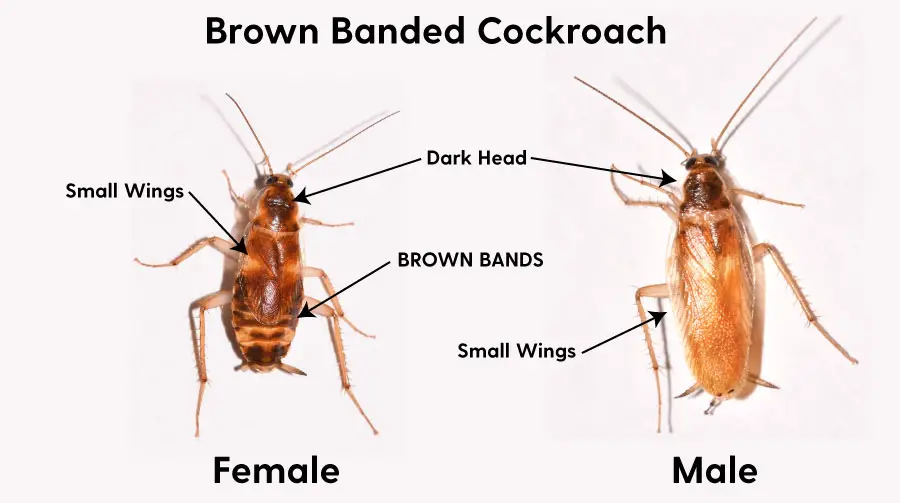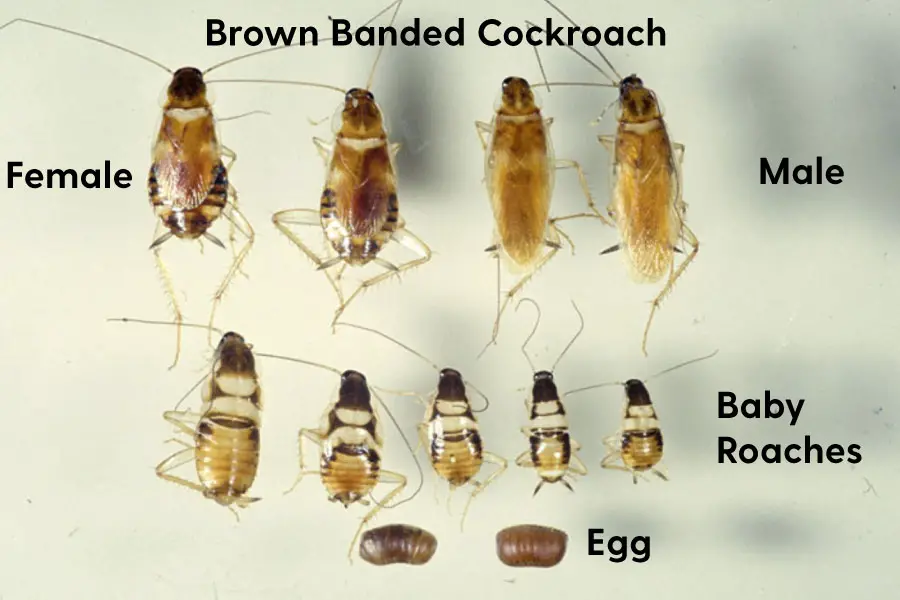Brown Banded Cockroach belongs to a small group of cockroaches and has successfully infested almost every place except Antarctica. Moreover, this cockroach has also suspiciously recognized itself as a dangerous roach because of its ability to spread diseases and trigger allergies.
The brown-banded cockroach is a 0.4 to 0.6 inch tan to dark brown small flat oval roach. It has two distinctive brown strips which run from left to right. The strips are not visible when the roach grows wings. The female Brown Banded cockroach and nymphs are darker than the adult male. The Brown Banded cockroach has tiny wings but can’t fly. Although they can hop and jump with help of these wings.
The Brown Banded cockroach is the second most common cockroach in the US and is found in almost every state, including Ohio, Arizona, Hawaii, Tennessee, Georgia, Michigan, and Texas.
Apart from other bad attributes associated with Brown Banded cockroaches, it is among the most hated cockroach of all because of its filthy untidy looks and awful, musty urine line smell. Furthermore, just like German cockroaches, the Brown Banded cockroach’s infestation should never be taken lightly because of its ability to multiply fast and spread quickly.
Brown Banded cockroach resembles other roaches very closely, such as Asian and German cockroaches, which is why a correct identification is necessary. Therefore, I have written this blog to help the reader quickly identify Brown Banded roaches, get rid of them, and Prevent future infestation.
Tired of cockroaches? Invest in only these products and follow the guide to eliminate roaches!
Use these products, and you will be roach free in less than a week.
1. Advion Cockroach Gel Bait (Review)
2. Gentrol IGR Point Source (Review)
Other Products to try:
1. Combat Roach Traps (Easy than gel baits)
2. Hot Shot Foggers (To kill in masses – 95%)
3. Pet Safe Killers (Uses Essential Oils)
4. Ortho Defence Outdoor Roach Killer (Prevent Roaches)
Appearance, and Identification Points
Do you know why professional exterminators first try to identify the type of roach? This is important because every species of cockroach has a different habitat, mode of infestation, and different prevention techniques.
Therefore, Proper identification of Brown Banded roaches is beneficial for extermination.

Appearance
The Brown Banded cockroach has a smooth and flat shiny tan to a dark brown oval-shaped body. It has two dark parallel stripes above its belly that run from left to right, unlike german roaches on which the strips run from head to bottom.
Brown Banded roaches have two long antennas longer than the body, three sets of tiny spiky legs, a paired, very prominent cerci, and a stylus. The female roach does not have a stylus.
Size
The adult Brown Banded cockroach measures between 0.4 to 0.6 inches long (1 to 1.5 cm). The female cockroach is a little bit smaller but broader than the male.
Wings
The body of Brown Banded roaches is covered with two sets of very tiny wings (visible and hidden) that do not extend beyond the body.
Brown Banded cockroaches can’t fly; however, they can glide for a very short distance under extreme threat, typically in a burst.
Bite
Although Brown Banded cockroaches stay away from human interaction, they are known to bite humans, especially during a heavy infestation. Brown Banded cockroaches bite the skin around fingernails, eyelashes, and the dead skin on human hands or feet.
Moreover, sleeping humans, especially babies and paralyzed older adults, are bitten by Brown Banded roaches.
Identification Points
Brown Banded roach closely resemble Asian cockroaches and can often be confused with them; however, both can be differentiated on the following points,
- Brown Banded roaches have tiny wings than Asian roaches.
- Brown Banded cockroach can’t fly whereas the Asian cockroach is an excellent flyer
- Brown Banded cockroach has two strips on its back that run from left to right.
German cockroach nymphs

Brown Banded cockroach nymphs are identical to adults, except they are dark brown to black and have the same distinct two strips which run from left to right. When molting, nymphs of the Brown Banded cockroach may appear white like an albino cockroach.
Nymphs also lack wings until puberty but have usual long antennas.
Distribution and Habitat
Brown Banded cockroaches have originated from Africa and they were brought into the United States from Cuba, potentially via infested ships. Now you can find them across the whole United States.
Interestingly, Brown Banded roaches are very sensitive to cold and can’t survive below 32 degrees Fahrenheit. Moreover, they need humans for food and warmth. Therefore they are closely related to humans and can’t survive without them, especially outdoors.
Brown Banded roach are mostly seen infesting buildings, hostels, guest houses, restaurants, food processing plants, and hotels. Unfortunately, hospitals and nursing homes are also not safe from the wrath of Brown Banded roaches.
Brown Banded Cockroach: Diet and Life Cycle
Brown Banded cockroaches are omnivorous and scavenge on everything from plant matter to meat. Under extreme food shortages, they can even turn cannibalistic, eating their peers or eating household items such as pieces of old clothes, soaps, and paper.
However, under normal conditions, Brown Banded roaches love to eat meaty, starchy, and sweet items like donuts, pieces of bread, and biscuits.
Life Cycle
Brown Banded roaches are the fastest reproducers among small roaches and quickly reach adulthood. Here are the stages of the life cycle of Brown Banded roaches,
Stage 1: Egg
Once the female and male reach adulthood, they start to mate. However, Brown Banded female usually mates only once in their life cycle.
After the female Brown Banded roach mates, she develops a capsule inside her abdomen called ootheca. Ootheca contains between 10 to 16 individual eggs. The female roach deposits the eggs somewhere hidden before it hatches in 30-46 days. Learn more about cockroach eggs here.
Stage 2: Nymph
The Brown Banded baby nymphs have to undergo approximately eight molting stages. In each molting stage to transform into adults, the cockroach sheds its exoskeleton to accompany the increasing size of the body. This stage takes approximately 30-40 days, and in the end, the Brown Banded cockroach has reached adulthood.
Stage 3: Adult
Once the Brown Banded cockroach has reached its adulthood it carries on to live for 6 to 8 months. The average life span of Brown Banded roaches from egg to the death of adult roaches is approximately 16 months.
Are Brown Banded Cockroaches Harmful?
Brown Banded cockroaches are dangerous because they visit sewerage, feed on filth, and then come back to live inside the kitchen and play on your utensils.
Every cockroach, including the Brown Banded cockroach, is harmful if it infests the home. Unfortunately, Brown Banded cockroach infests home and indoor spaces with great severity and transmits diseases like typhoid and paratyphoid fever, Dysentry, and Cholera.
They also threaten susceptible individuals, including patients with known allergies to cockroach droppings, exoskeleton, and saliva. Brown Banded cockroaches are also known to trigger asthma episodes in an atopic individual.
In most cases, the once Brown Banded roaches once move indoors, they quickly establish their colony. Soon the place will turn into a breeding ground with hundreds of roaches moving around.
In such cases, the Brown Banded cockroach is a threat to the property, significantly affecting the selling price in the market.
Do you know that some people have an extreme fear of roaches called Katsaridaphobia? Read this fascinating article to know more about it.
Preventing and Getting Rid of Brown Banded Cockroach Infestation
Before controlling the Brown Banded cockroach infestation, look for a Brown Banded cockroach infestation signs. It will help exterminate and prevent them easily.
Signs of a Brown Banded Cockroach Infestation

- Brown Banded cockroach dropping in cockroach hiding places such as Kitchen and bathroom cabinets, under the sink, wardrobe, behind and inside the refrigirators and ovens.
- Desqumated exoskeleton in multiple places around the house
- Brown Banded cockroach nest with live and dead roaches, nymphs, and eggshells.
- Musty urine-like smell is also a major sign of Brown Banded roach infestation.
Brown Banded Cockroach Prevention
Preventing Brown Banded cockroach infestation is sometimes difficult because they move indoors via multiple routes. However, the following tips will help you get the maximum benefit,
- Regularly clean the house and wash the floor or tiles with detergents at least fortnightly.
- Do not leave food bites on the floors or leftover food inside the kitchen.
- Cover the garbage bins properly sitting inside and outside the house.
- Cover the bathroom drains with anti cockroach drains.
- Fix any openings in electric boards and circuits.
- Fix any door gaps or leaking pipes with masking tape.
- Inspect groceries, luggage, or any other item before moving them indoors.
- You can also use Natural Roach Repellents to keep Brown Banded roaches at bay.
- Use IGR spray to prevent Brown Banded cockroach nymphs from transforming into adults.
Three Easy and Quick Methods to Get Rid of Brown Banded Cockroach
These are three methods that will help you solve your Brown Banded roach problem,
Method 1: Using a bait
This method uses bait to get rid of Brown Banded cockroaches. Baits are better than sprays as baits will kill the entire colony.
All you need to do is, read this guide and apply bait inside your bathroom, cupboards, kitchen cabinets, and basement, all the favorite spots of Brown Banded cockroaches.
You can get your hand on many baits, but these are my favorite ones. Use each of them according to instructions on the pack.
– Bengal Roach Killer is a dry spray bait, very easy to apply and use. (How to use guide)
– Advion Cockroach Gel Bait is the most effective gel you can buy.
– Hot Shot Liquid Cockroach Trapper and Killer is the best trap you can get for cockroaches.
– Combat Max 12 Month Roach Killing Bait is the best bait out on the market.
Method 2: Using an IGR
Using an IGR helps ensure the Brown Banded roach nymphs don’t grow into adults. The Brown Banded cockroach is a notoriously fast breeder, and all they need is an optimum temperature, a lot of food, and humidity to reproduce throughout the year.
Therefore, using an IGR spray will keep Brown Banded roaches in check for you.
An IGR alters the internal hormones of roaches to molt. This way, the roaches will not become adults and fail to reproduce. Gentrol Growth Regulator (Amazon Link) is the only and the best IGR device for roaches.
It’s effortless to use. Just purge one of them and place it in a hidden place inside your bathroom.
Method 3: Insecticide Spray or Roach Bombs
Insecticide spray or roach bombs are quick solutions for getting rid of Brown Banded cockroaches in difficult-to-reach places. However, roach bombs kill German roaches but do not destroy the eggs; we may start to see roaches again after a few weeks.
To get rid of Brown Banded cockroaches, you must seal all doors and windows, turn off ventilators or air conditioning and spray around all the corners and cockroach hiding places. Then, wait for 30 minutes before you ventilate the room.
Other methods such as using Diatomaceous Earth powder and Boric acid will also kill Brown Banded roaches indoors, but these methods are messy and difficult to use.